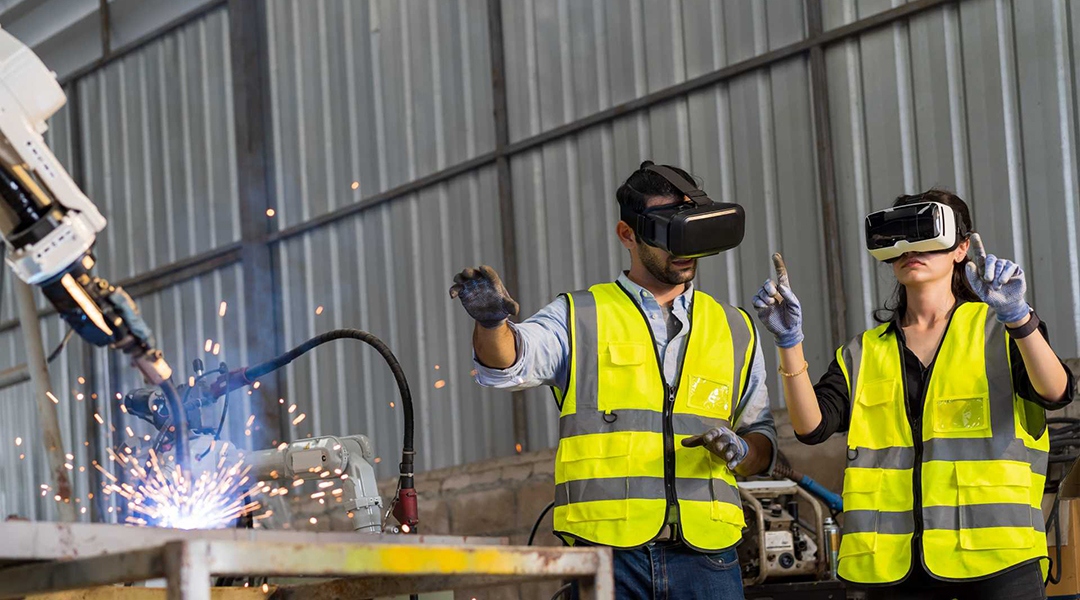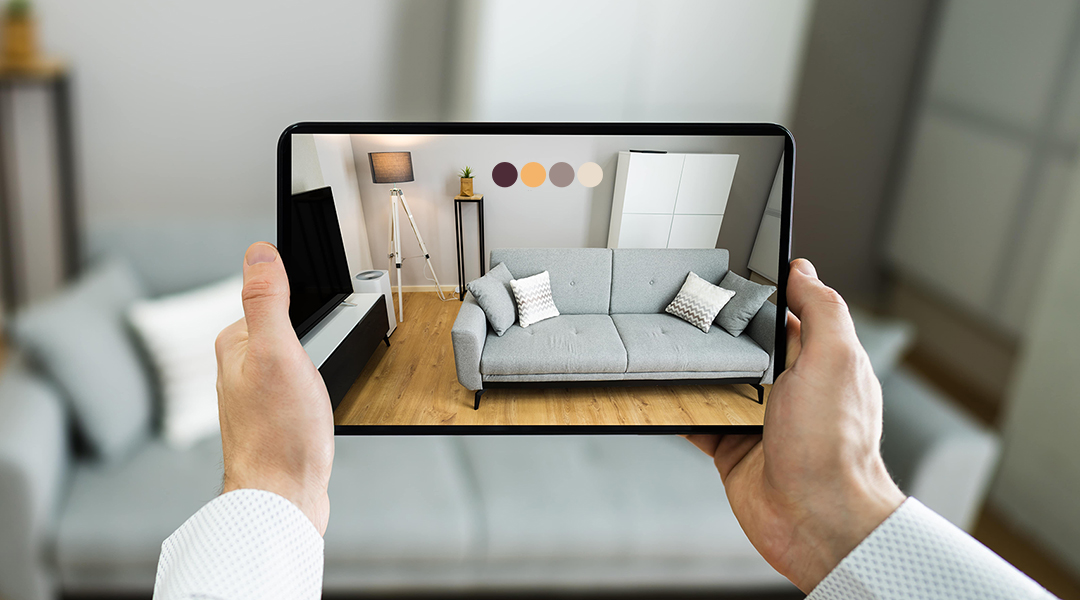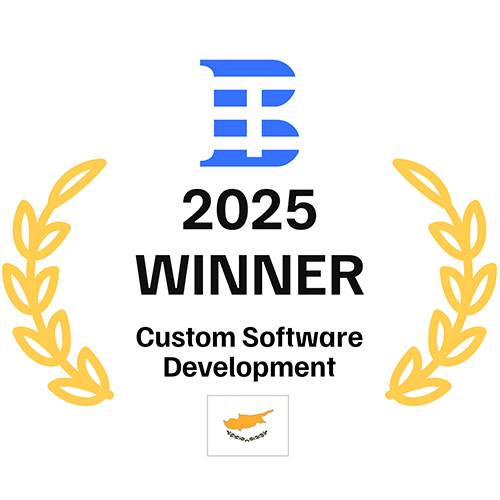Virtual reality app development has become crucial for businesses looking to engage users innovatively. The development process involves meticulous planning, cutting-edge technology, and a deep understanding of user needs. From the initial concept to the final deployment, each step requires attention to detail and technical expertise.
Virtual reality app development offers numerous benefits, including enhanced user engagement, improved learning experiences, and realistic simulations. Businesses can leverage these applications to train employees, entertain customers, and provide virtual tours. The growth in VR technology presents significant opportunities for companies to differentiate themselves and deliver unique value.
Partnering with a skilled virtual reality app development company ensures access to the latest advancements and expert guidance throughout the project. By staying current with technological trends, businesses can fully utilize the potential of VR applications.
Embracing VR App Development for Business Growth
Virtual reality app development offers significant opportunities for businesses to engage users and drive growth. Partnering with an experienced development company can help create immersive experiences tailored to business needs. The increasing adoption of mobile VR devices highlights the importance of virtual reality mobile app development.
VR Market Size Worldwide
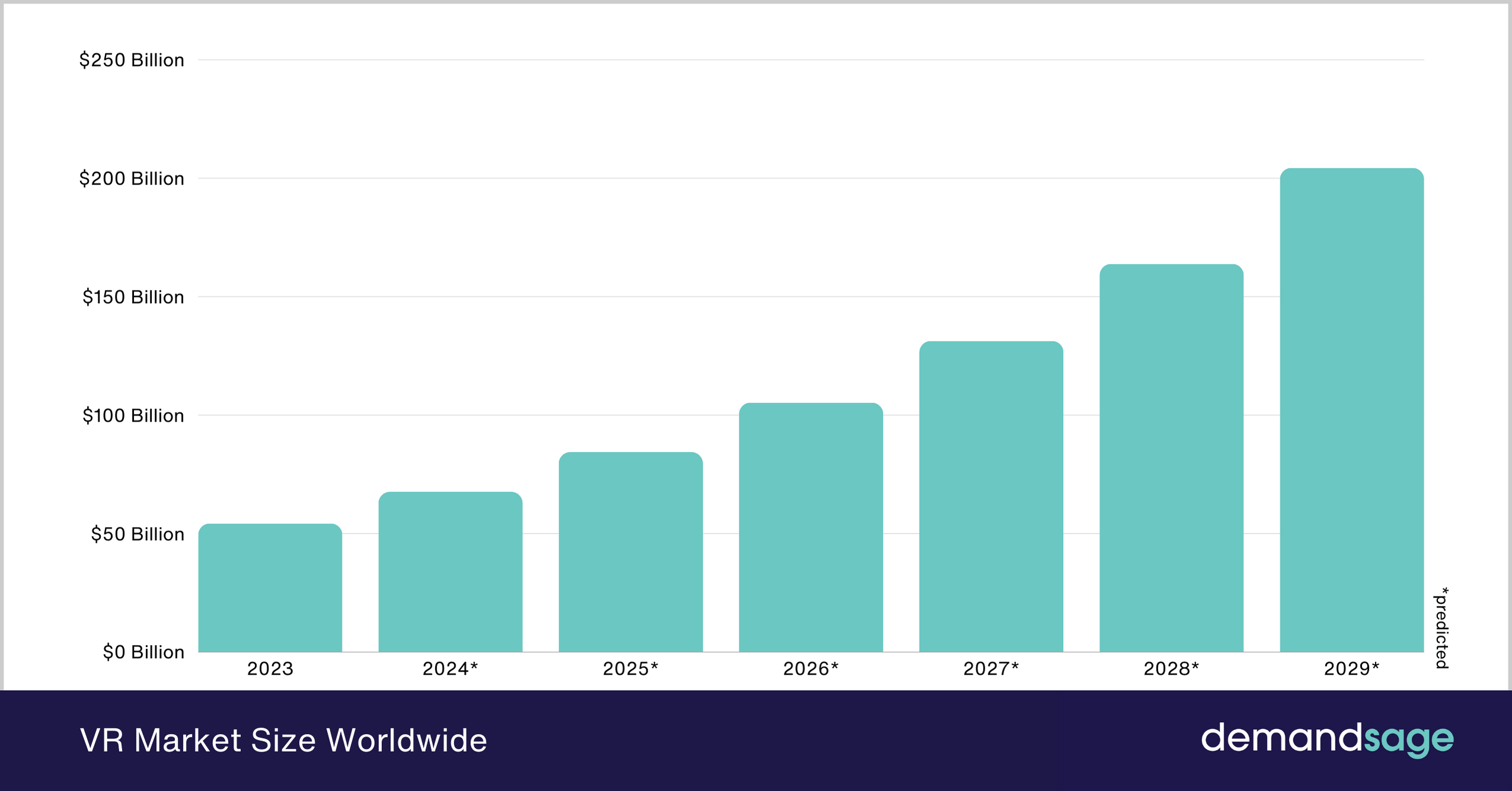
Creating a VR app involves several key steps. First, define the business objectives and understand the target audience. Next, plan the project in detail, then build the app using platforms like Unity or Unreal Engine. Thorough testing and refinement are essential to ensure the app meets quality standards.
To start with:
- Define objectives. Determine the goals of the VR app and identify the target audience.
- Plan the project. Develop a detailed plan outlining the app’s features and timeline.
- Build the app. Use VR development platforms such as Unity or Unreal Engine to create the app.
- Test and refine. Conduct rigorous testing to ensure the app functions correctly and meets user expectations.
Businesses in various industries benefit from VR apps. Retailers can offer virtual store tours to enhance customer engagement. Educational institutions use VR for immersive learning experiences, improving student outcomes. Healthcare professionals practice procedures in a risk-free virtual environment, boosting precision and confidence.
Choosing the right virtual reality app development company ensures access to the latest technological advancements. Experienced developers provide valuable insights and support throughout the development process, helping businesses achieve their objectives efficiently.
Embracing VR app development can significantly enhance business growth by offering innovative ways to engage customers and improve operations. Leveraging expertise from top developers and following a structured development process leads to high-quality VR apps that deliver tangible benefits.
Benefits of Custom VR Apps
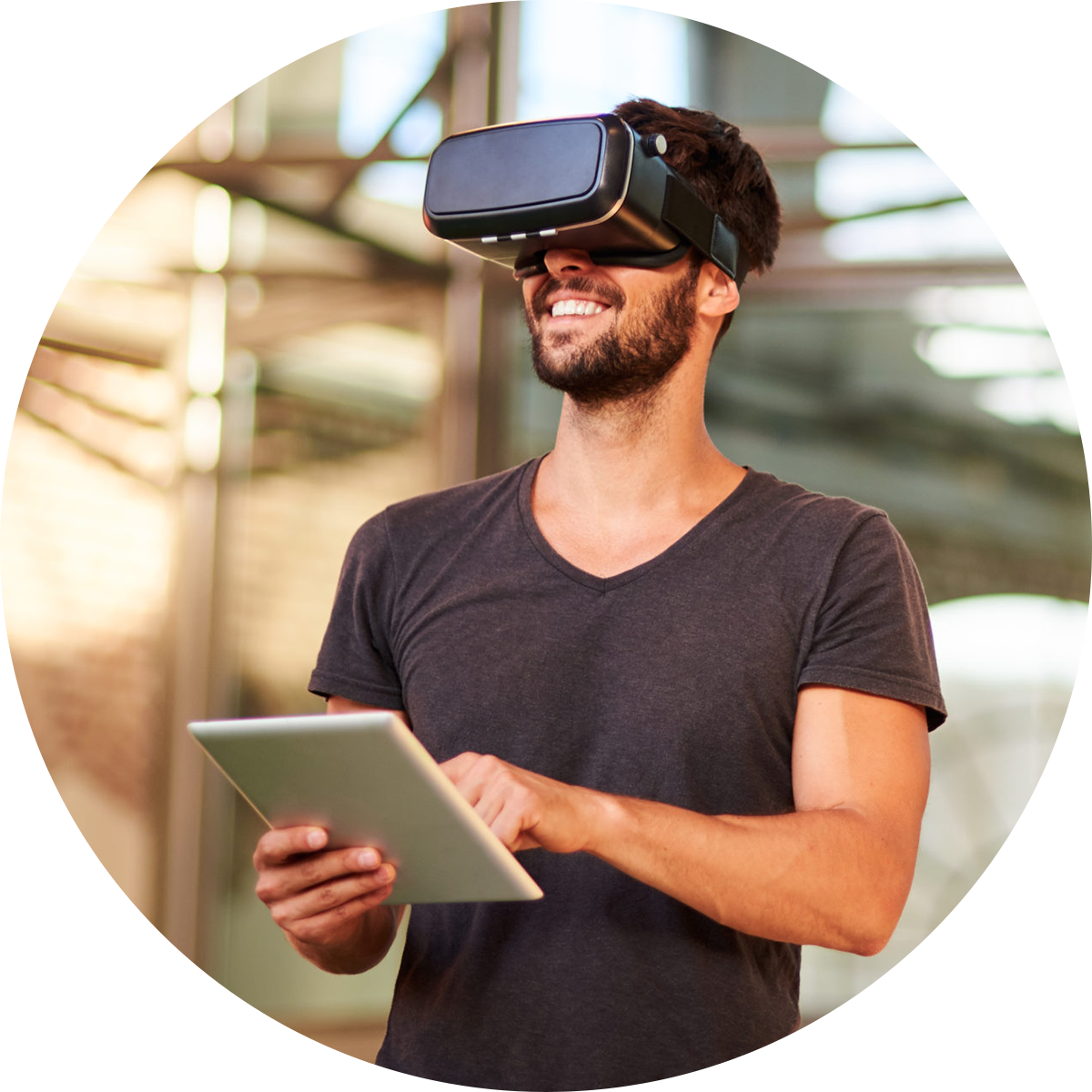
Custom VR apps offer numerous advantages for businesses seeking to differentiate themselves. Tailored experiences meet specific business needs and customer preferences, unlike generic solutions. Custom VR apps include unique features and functionalities aligned with company goals.
Enhanced user engagement stands out as a primary benefit. Immersive VR experiences capture attention more effectively, increasing interaction and satisfaction. Interactive elements, realistic simulations, and personalized content ensure that users remain engaged and invested in the experience. Businesses that leverage these aspects see a marked improvement in user retention and overall satisfaction.
Improved training and simulation represent another significant advantage. Custom VR apps create realistic training environments, allowing employees to practice skills in safe settings. High-risk industries like healthcare and manufacturing benefit greatly from this approach. For example, medical professionals can practice complex surgeries in a virtual setting, reducing the risk of errors in real-life procedures. Similarly, manufacturing workers can simulate the operation of heavy machinery, enhancing their skills without the associated risks.
Custom VR apps also provide better analytics and insights. Data on user interactions helps businesses understand product usage, guiding informed decisions and future improvements. Detailed analytics allow companies to track performance, identify areas for improvement, and make data-driven adjustments to enhance the overall user experience. This level of insight is invaluable for refining products and services, ensuring they meet customers' evolving needs.

Enhanced engagement. Immersive experiences increase user interaction and satisfaction. Realistic simulations, interactive elements, and personalized content ensure that users remain invested in the experience.

Improved training. Realistic simulations allow the safe practice of essential skills. Virtual practice environments that reduce errors and enhance proficiency benefit high-risk industries.

Valuable insights. Analytics on user interactions inform business decisions. Detailed data tracking helps refine products and services, ensuring they effectively meet customer needs.

Tailored features. Custom functionalities align with specific business goals. Unique features and integrations make the VR app more effective in achieving desired outcomes.
Therefore, custom VR apps offer significant benefits, including enhanced engagement, improved training, and valuable insights. Collaborating with the top virtual reality development companies helps businesses create tailored VR experiences that drive growth and success.
How to Develop VR Apps Relying on Market Insights
Understanding market trends is crucial for successful VR application development. Leveraging these insights helps create apps that meet user needs and stay competitive. Developers may foresee demands and customize their applications by studying customer preferences and new technology. Such a forward-thinking strategy keeps virtual reality apps current and gives them a leg up in the dynamic VR industry.
Understanding the Basics of VR App Development
Developing a VR app involves several key steps and requires a comprehensive understanding of various technologies. Knowing how to develop VR apps starts with defining the app’s purpose and target audience. This foundational step ensures the app meets specific needs and provides value to users.
Once the purpose is clear, the development process begins with creating a detailed project plan. This plan outlines the app’s features, user interactions, and overall design. Choosing the right development platform is essential, with Unity and Unreal Engine being the most popular choices. Each platform offers unique advantages; however, VR development in Unreal Engine is particularly known for its high-quality graphics and realistic simulations.
Designing the user experience (UX) is a critical phase in VR app development. The UX should be intuitive and immersive, allowing users to navigate the virtual environment seamlessly. Developers often create prototypes to test and refine the UX before moving on to complete development. After finalizing the UX, the development team builds the app’s core functionalities, including programming interactions, integrating 3D models, and ensuring smooth performance across VR devices. Rigorous testing is crucial to identify and fix any issues, ensuring the app runs flawlessly.
Finally, the app is ready for deployment. Post-launch support is essential to address any user feedback and update the app as needed. Continuous improvement based on user input helps maintain the app’s relevance and effectiveness.
Key Technologies and Tools for VR Development
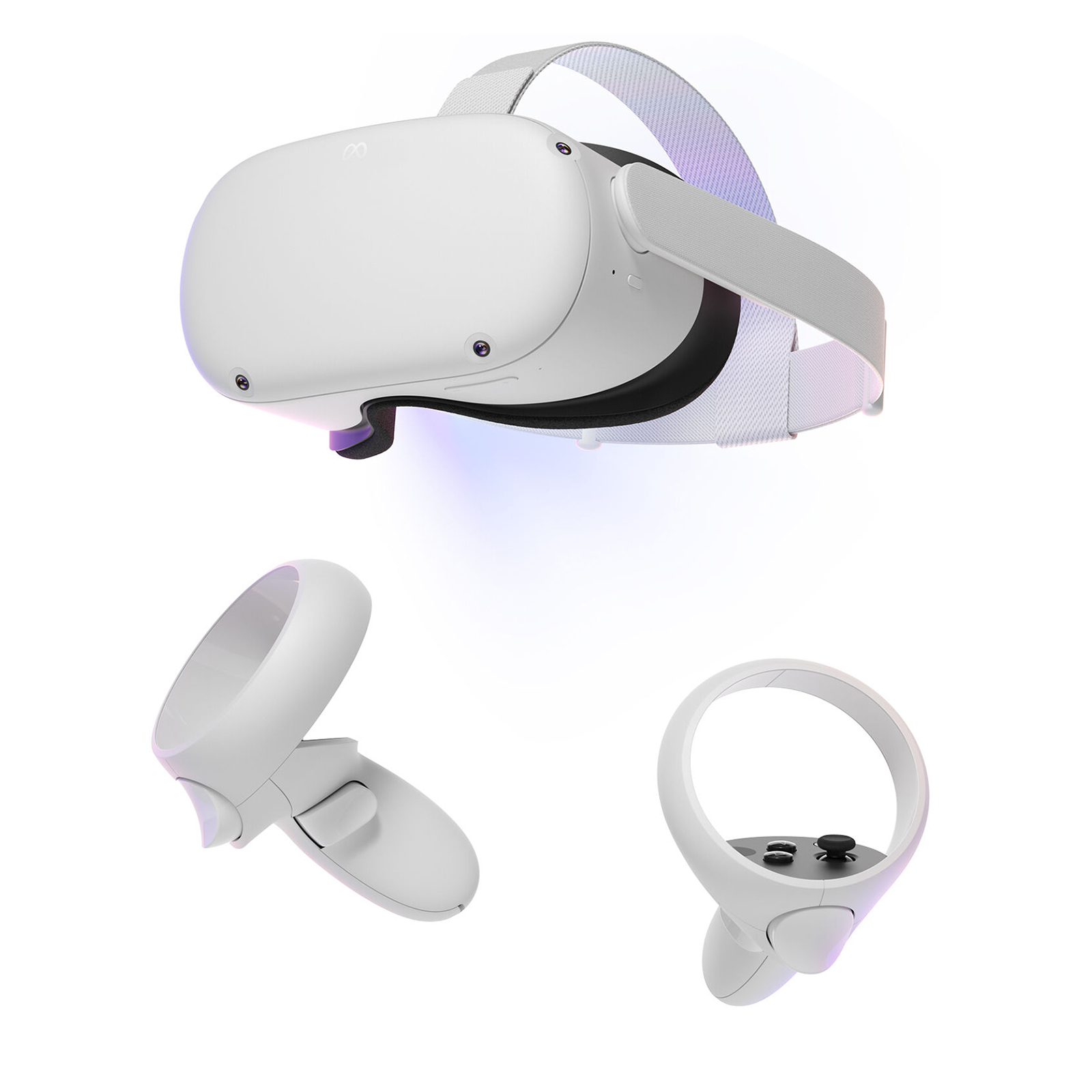
Developing high-quality VR apps requires a deep understanding of various technologies and tools. These tools are essential for creating immersive and engaging experiences that meet modern user expectations.
- 3D modeling software. Tools like Blender and Autodesk Maya enable developers to create detailed and realistic 3D environments and objects. These models are the building blocks of any VR experience, providing the visual richness that users expect.
- Game engines. Unity and Unreal Engine are the top choices among developers. Unity is known for its versatility and extensive asset store, making it suitable for various VR applications. Unreal Engine delivers high-fidelity graphics and realistic physics, which is ideal for applications requiring stunning visual quality.
- Motion tracking systems. Integration of systems like HTC Vive trackers or Oculus sensors allows for precise tracking of user movements, enhancing the sense of immersion. Accurate motion tracking is vital for creating intuitive and responsive VR interactions.
- Performance optimization tools. These tools help identify and resolve performance bottlenecks, ensuring smooth and lag-free experiences. Techniques like level of detail (LOD) management and efficient rendering practices are commonly employed.
- Collaboration and version control tools. Platforms like GitHub facilitate collaboration among team members, enabling efficient project management and version control, which ensures all team members can work on different project parts simultaneously without conflicts.
By leveraging these key technologies and tools, developers can create high-quality VR applications that provide immersive and engaging experiences. Understanding the capabilities and limitations of each tool helps developers make informed decisions, ultimately leading to better end products.
What VR App Developers to Hire for Your Project
The success of your project hinges on your choice of virtual reality app developers. Think about the developer's portfolio, technical abilities, and experience when you search for the best one. Skilled programmers will have a history of satisfying customers with top-notch virtual reality apps.
- Knowledge in technical areas. You should check that the programmers have a good grasp of Unity and Unreal Engine, two crucial technologies. They also need to be familiar with motion tracking devices and 3D modeling tools to create lifelike and engaging virtual reality experiences.
- Portfolio and case studies. One way to learn about a developer's skills and experience is to look at their portfolio. Try to find examples of their work that show how they have taken on complex challenges and come up with creative solutions.
- Testimonials from satisfied customers. The developer's dependability, communication abilities, and general performance might be better understood by reading feedback from prior clients. Customer satisfaction and effective project completion are shown via positive testimonials.
- Teamwork and dialogue. Open lines of communication are critical at every stage of development. To guarantee the success of your project, choose professionals who are responsive and eager to work directly with you.
- Abilities to resolve problems. Developing a virtual reality app typically entails conquering technological obstacles. Developers need to be good problem solvers to keep the project on schedule.
Considering these will help you find VR app developers who are up to realizing your vision. Hiring competent programmers increases the likelihood that your virtual reality app will succeed commercially and guarantees its high quality.
The Tiniest Details of Your Preferred VR App Development Process
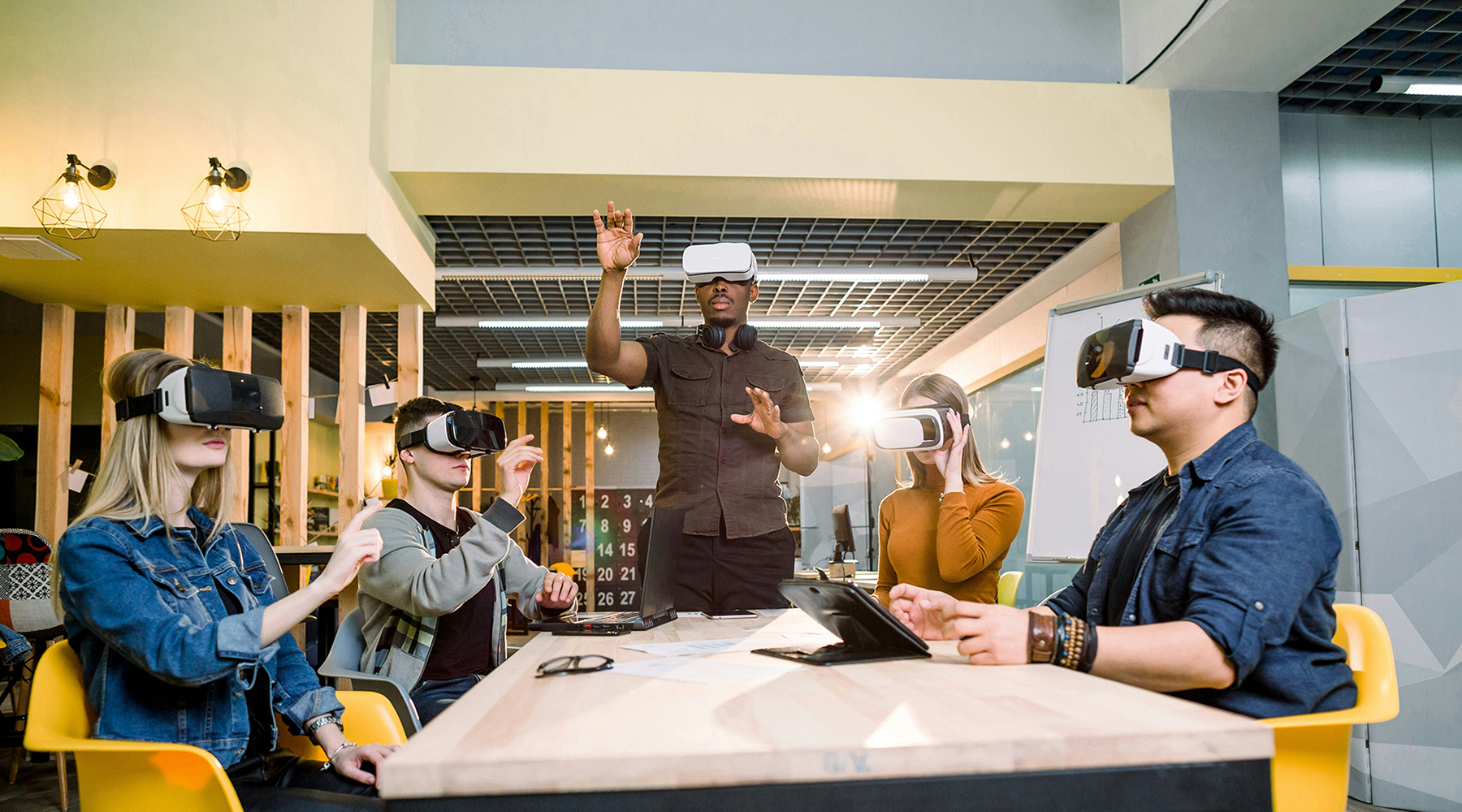
To get the most out of your virtual reality software, you need to know how it's made. In order to make sure the app satisfies specific requirements, the first step is to define precise objectives and determine the target audience. The next step is to create a visually appealing and functional user interface using a game engine such as Unity or Unreal Engine.
The app must undergo extensive testing to guarantee that it works as intended and is of high quality. Finally, in order to fix issues and keep the software running well, it is released and maintained constantly. An excellent virtual reality software that satisfies users and accomplishes company objectives results from painstaking attention to detail throughout the process. Now let’s talk about the VR app development process in greater detail!
1. Initial Planning and Conceptualization
Creating a VR app begins with thorough planning and a clear conceptual framework. Understanding how to create a VR app involves several critical steps. First, identify the primary objectives of the app. Knowing what you want to achieve guides the entire development process and ensures the final product meets user needs.
The next step involves researching the target audience. Understanding who will use the app and what they expect from it helps in designing features and functionalities that cater to their preferences. Market analysis can provide valuable insights into user behaviors, preferences, and expectations, which are crucial for crafting an app that stands out.
With a clear objective and audience in mind, the development team can move on to brainstorming and ideation. This phase involves generating ideas that align with the app's goals and user needs. It is important to consider various aspects, such as user interactions, visual elements, and the overall user experience.
Following brainstorming, detailed documentation should be created. This documentation should include the app's features, technical requirements, and design specifications. It serves as a roadmap for the entire development process, ensuring all team members are on the same page.
Prototyping is an essential part of the initial planning phase. Building a prototype helps visualize the app's functionalities and user interface. It allows for early testing and feedback, enabling developers to make necessary adjustments before moving on to full-scale development.
Finally, setting a realistic timeline and budget is crucial. Allocating resources effectively and setting achievable milestones ensures the project stays on track. Regular reviews and updates during the planning phase help address any issues promptly, providing a smooth development process.
2. Design and Prototyping
Designing and prototyping are critical stages in VR app development. These phases shape the user experience and determine how effectively the app meets its objectives. The design process starts with creating wireframes outlining the app’s structure and layout. Wireframes serve as a blueprint, highlighting the placement of various elements and ensuring a logical flow of information.
Once wireframes are approved, the next step is to create detailed design mockups. These mockups incorporate visual elements such as colors, typography, and graphics. The goal is to create an aesthetically pleasing interface that enhances user engagement. Designers should focus on creating an intuitive and immersive experience that aligns with the app’s purpose.
Prototyping follows the design phase. A prototype is a working model of the app that allows for testing and validation of its features. Prototyping tools like Adobe XD or Figma can create interactive prototypes that simulate the user experience. This step is crucial for identifying potential issues and gathering user feedback early in development.
User feedback is invaluable during the prototyping phase. Conducting usability tests with a sample of the target audience helps in understanding how users interact with the app. Feedback from these tests can highlight areas that need improvement, ensuring the final product meets user expectations.
Iterating on the prototype based on feedback is essential. Developers should make necessary adjustments and enhancements to refine the app’s design and functionality. This iterative process helps in creating a robust and user-friendly app.Developers can ensure the app provides a seamless and engaging user experience by focusing on detailed design and thorough prototyping. These steps are fundamental in any virtual reality project, including iOS and Android VR app development. If your team follows it, you’ll get a high-quality final product that resonates with users.
3. Development and Testing
Developing VR apps requires a structured approach to transform concepts and designs into a functional application. The development phase begins with setting up the development environment, choosing the appropriate software tools, and selecting the right VR platforms, such as Unity or Unreal Engine. Each tool offers unique features and capabilities, so picking the one that best fits the project requirements is crucial.
Developers start coding the core functionalities, integrating 3D models, animations, and user interfaces designed in the earlier phases. Attention to detail during coding ensures the app performs seamlessly across different VR devices. Real-time collaboration tools can facilitate smooth communication among team members, making it easier to address any issues that arise during development.
Testing is an integral part of the development process. Conducting various tests, including unit, integration, and user acceptance tests, ensures the app functions correctly and meets the set quality standards. VR apps require additional focus on usability and performance testing. These tests help identify any issues related to user interaction, responsiveness, and overall performance.
For usability testing, real users interact with the app to provide feedback on their experience. This feedback is crucial for identifying any areas that need improvement. Performance testing involves assessing the app’s performance under different conditions, ensuring it runs smoothly without lag or crashes.
Iterative testing and development cycles are typical in VR app development. Developers continuously refine and enhance the app based on feedback from testing, ensuring the final product is polished and ready for deployment. By focusing on meticulous development and rigorous testing, developers can create high-quality VR apps that deliver immersive and engaging experiences.
4. Deployment and Maintenance
Once development and testing are complete, the VR app is ready for deployment. Deployment involves several critical steps to ensure the app reaches its intended users effectively. First, prepare the app for distribution by packaging it correctly and ensuring all necessary files and configurations are included. Depending on the target platform, developers may need to follow specific guidelines for app submission.
The next step is to submit the app to VR app stores, such as the Meta Store or Google Play for Android VR apps. Each platform has its review process, where the app is evaluated for compliance with its standards. Ensuring the app meets these standards increases the likelihood of a smooth approval process.
After the app is launched, ongoing maintenance is essential to keep it functioning optimally and to address any issues that arise post-deployment. Regular updates are crucial for fixing bugs, improving performance, and adding new features based on user feedback. Monitoring user reviews and app store feedback provides valuable insights into areas that need improvement.
Developers should also track the app’s performance using analytics tools. These tools help monitor various metrics, such as user engagement, crash reports, and usage patterns. Understanding how users interact with the app enables developers to make informed decisions about future updates and enhancements.
Security updates are also a critical aspect of maintenance. Ensuring the app is protected against vulnerabilities helps maintain user trust and data integrity. Regularly updating the app’s security protocols and addressing any potential threats promptly is essential.
Effective deployment and diligent maintenance ensure that the VR app remains relevant and continues to deliver a high-quality experience to users. By staying proactive and responsive to user needs, developers can ensure the long-term success of their VR applications.
Jump-start your VR app development project with us!
How Much Does it Cost to Develop a VR App?
The cost of developing a VR app varies widely and is influenced by factors such as complexity, features, development time, and the development team's expertise. Additional costs may include design, testing, and post-launch support.
Factors Influencing VR App Development Costs
Several factors significantly influence the cost of developing a VR app. Understanding these factors helps in planning and managing the budget effectively.
- Complexity and features. The more complex the app, the higher the cost. Advanced features like real-time interactions, high-quality 3D graphics, and multiplayer capabilities increase development time and expenses.
- Development platform. The choice between platforms such as Unity or Unreal Engine affects the cost. Each platform has different licensing fees, development tools, and support systems that impact the overall budget.
- Design and user experience. High-quality design and a seamless user experience are crucial for VR apps. Detailed 3D modeling, animations, and intuitive interfaces require skilled designers, contributing to higher costs.
- Development team expertise. The experience and skills of the development team play a significant role. Hiring top virtual reality development companies or seasoned developers generally costs more but ensures a higher quality product.
- Testing and quality assurance. Rigorous testing is essential to ensure the app functions correctly across various devices. Comprehensive testing cycles add to the development costs, including usability, performance, and compatibility tests.
- Post-launch support and updates. Ongoing maintenance, bug fixes, and feature updates are necessary for the app's long-term success. Budgeting for post-launch support ensures the app remains functional and up-to-date.
- Integration with external systems. Integrating the VR app with existing systems, such as databases or other software, can increase complexity and cost. Custom APIs and middleware development may be required.
Without a doubt, if you consider the aspects mentioned above, you can better estimate how much it costs to create virtual reality software.
Budgeting for Your VR App Project
Creating a realistic budget for your VR app project is essential for successful development and deployment. Start by outlining the project’s scope and objectives, which will help estimate the required resources and associated costs.
- Initial planning. Allocate funds for the initial planning and conceptualization phase, including market research, target audience analysis, and defining the app’s features and functionalities.
- Design and prototyping. Budget for high-quality design and prototyping. Investing in detailed 3D models, animations, and user experience design ensures the app’s visual and interactive appeal. Prototyping tools and iterative testing also require financial resources.
- Development. Estimate the cost of hiring skilled developers and choosing the right development platform. Whether you opt for Unity, Unreal Engine, or another platform, factor in licensing fees, development tools, and the expertise needed.
- Testing and quality assurance. Allocate a portion of the budget for comprehensive testing. This encompasses usability testing, performance evaluation, and ensuring compatibility across different VR devices. A thorough quality assurance process prevents costly post-launch issues.
- Marketing and launch. Plan for marketing expenses to promote the app upon launch. Effective marketing strategies, including social media campaigns, influencer partnerships, and online advertisements, help attract users and generate interest.
- Post-launch support. Set aside funds for ongoing maintenance and updates. Addressing user feedback, fixing bugs, and adding new features are crucial for keeping the app relevant and functional. Regular updates enhance user satisfaction and retention.
- Contingency fund. Include a contingency fund to cover unexpected expenses. Development projects often encounter unforeseen challenges, and having a financial buffer ensures the project stays on track without compromising quality.
By carefully budgeting for each phase of the VR app development process, businesses can manage costs effectively and ensure a successful project outcome. Regularly reviewing and adjusting the budget as the project progresses helps maintain financial control and momentum.
Cost-Saving Tips Without Compromising Quality
Developing a high-quality VR app can be expensive, but there are effective strategies to save costs without compromising quality. Here are some practical tips:
Define clear objectives. Start with a well-defined project scope and clear objectives. Knowing precisely what you want to achieve helps avoid unnecessary features and functionalities that can increase costs.
Use existing assets. Leveraging pre-built assets and libraries can save significant development time and costs. Platforms like Unity Asset Store offer a wide range of 3D models, textures, and animations that can be integrated into your app.
Outsource strategically. Outsourcing parts of the project to experienced developers or agencies in regions with lower labor costs can help reduce expenses. Ensure that the outsourced team has a proven track record to maintain quality.
Iterative development. Adopt an iterative development approach. Build a minimum viable product (MVP) first, then gradually add features based on user feedback. This method ensures you only invest in features that users truly need and appreciate.
Optimize for performance. Efficient coding practices and performance optimization can reduce development time and costs. Optimizing 3D models, reducing polygon counts, and using efficient algorithms help create a smooth user experience without overloading the system.
Automate testing. Implement automated testing tools to catch bugs and issues early in development. Compared to manual testing, automated testing saves time and resources and ensures consistent quality.
Choose the right platform. Select a development platform that aligns with your project requirements and budget. Unity and Unreal Engine offer robust tools, but their cost structures differ. Choose the one that best fits your needs.
Plan for scalability. Design your app with scalability in mind. A modular architecture allows you to add new features without extensive rework, saving time and money in the long run.
Implementing these cost-cutting suggestions can help you efficiently control your VR app development budget while maintaining high-quality standards. If you consider these elements, you may better estimate the possible expenses of producing VR software and plan your budget appropriately.
VR Hotel Configurator Development with Program-Ace
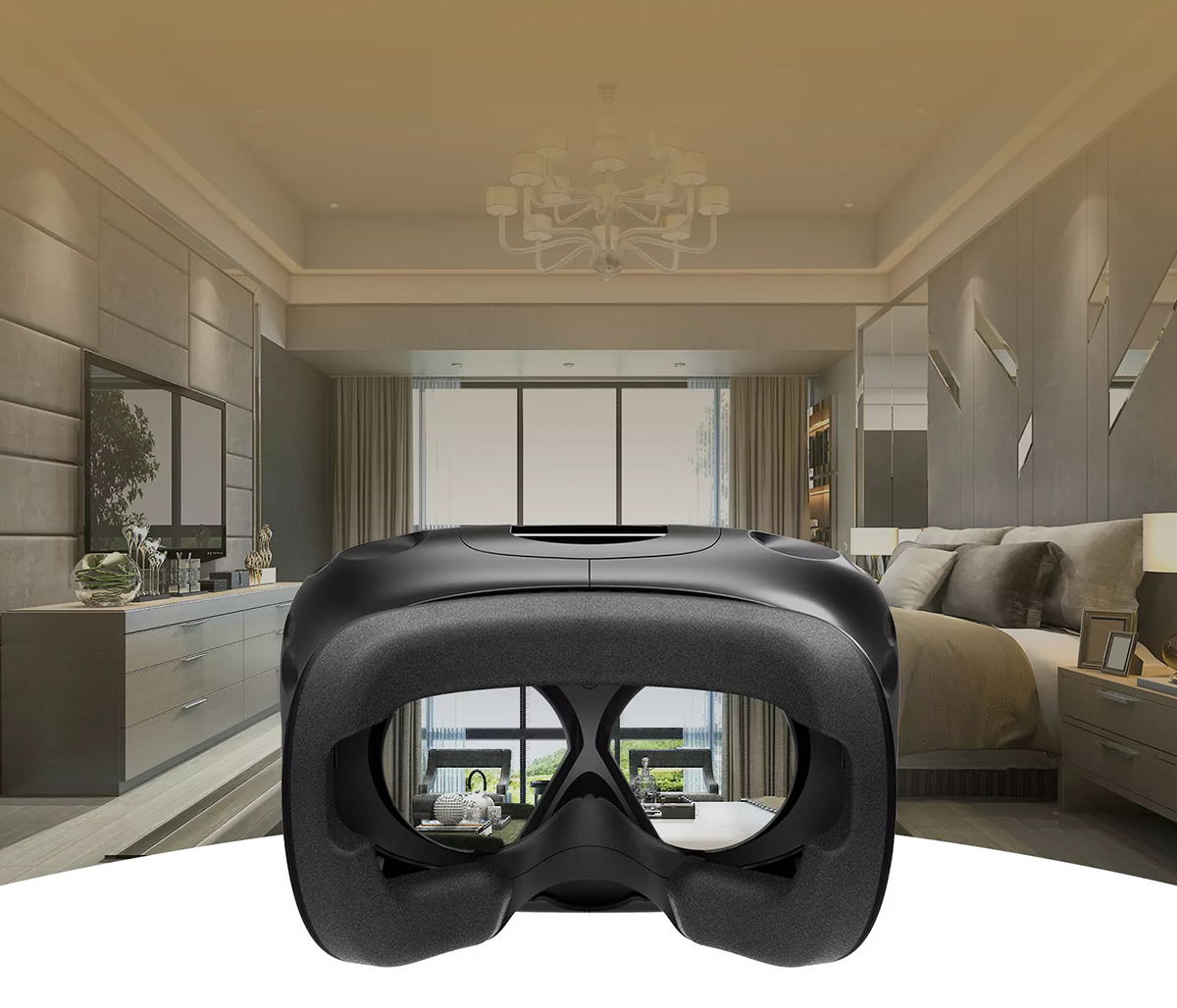
Discover how Program-Ace's VR Hotel Configurator enhances interior design planning with an immersive, interactive virtual reality experience. This app allows hotel staff to efficiently perform assessments, measurements, and design planning in a realistic virtual environment, reducing costs and time.
Five Sectors Leading the Way with Virtual Reality Technologies
As a result of its novel solutions and improved user experiences, virtual reality is revolutionizing a number of sectors. Here are five areas where virtual reality is already having a major influence:
-
Healthcare
Virtual reality in healthcare revolutionizes medical training, patient treatment, and therapy. Medical professionals use VR simulations to practice complex surgeries and procedures, reducing risks associated with real-life operations. Patients benefit from VR-based therapies for conditions like PTSD and chronic pain, providing immersive and effective treatments.
-
Automotive
The automotive industry leverages virtual reality for design, manufacturing, and customer engagement. VR allows engineers to visualize and test vehicle designs in a virtual environment, identifying potential issues early in development. Customers experience virtual test drives, exploring vehicle features and configurations without visiting a showroom. That’s how virtual reality in automotive can enable businesses to move forward without any compromises.
-
Education
VR is transforming education by providing immersive learning experiences. Students engage with interactive simulations, exploring subjects like history, science, and geography in a virtual environment. This hands-on approach improves understanding and retention, making learning more engaging and effective.
-
Manufacturing
Virtual reality enhances training, design, and production processes in manufacturing. Workers use VR simulations to learn complex machinery operations and safety protocols, reducing on-site accidents and improving efficiency. VR also assists in prototyping and testing new products, speeding up the development cycle and reducing costs. So, virtual reality in manufacturing is certainly a technology to take into account if you are part of this industry.
-
Real Estate
The real estate sector benefits from VR by offering virtual property tours. Potential buyers can explore properties from anywhere in the world, experiencing realistic views and layouts. VR tours save time and resources for both buyers and sellers, streamlining the property-buying process.
These sectors demonstrate the versatility and potential of virtual reality technologies. By integrating VR into their operations, industries can enhance efficiency, reduce costs, and provide better user experiences.
Custom VR App Development — Tailored Solutions for Any Needs
Custom VR app development offers tailored solutions to meet unique business needs. From immersive training to interactive simulations, personalized VR apps enhance user experiences and operational efficiency.
Cases of Successful Custom VR Solutions
Custom VR solutions have shown significant success across various industries, demonstrating their versatility and effectiveness.
Cedars-Sinai Medical Center has implemented VR technology in healthcare to help patients manage pain. The hospital uses custom VR applications to create immersive experiences that distract patients from pain and anxiety. For example, patients can explore virtual environments like beaches or forests, which have been shown to reduce pain levels and reliance on medication.
Ford Motor Company utilizes VR to improve its vehicle design and prototyping processes in the automotive industry. At Ford's Immersive Vehicle Environment (FiVE) lab, engineers and designers use VR headsets to visualize and interact with virtual car models. The technology allows them to identify design issues and make improvements early in development, significantly reducing the need for physical prototypes. By using VR, Ford accelerates its design cycles and cuts costs, showcasing the practical benefits of virtual prototyping.
In manufacturing, Boeing employs VR for worker training and simulation. VR technology allows Boeing to create detailed simulations of aircraft assembly processes, providing workers with a safe environment to practice and hone their skills. By enabling employees to become acquainted with complicated jobs without the hazards connected with real-world training, this strategy increases training efficiency and boosts safety. Boeing's use of VR demonstrates how custom VR solutions can optimize workforce training and operational efficiency.
Finally, you can always read more about the success stories of Program-Ace. Just look at how we developed Magrabi VR Store to get inspired!
How to Choose the Right Development Partner
The success of a bespoke VR app development project depends critically on the choice of a development partner. Analyzing the experience and knowledge of the possible mate comes first. Search for a development team experienced in producing excellent virtual reality applications. Examining their portfolio and case studies helps one better understand their capacity and the difficulty of the projects they have managed.
Equally vital is knowing the technical abilities of the development team. Make sure they are fluent in the newest VR systems and platforms, including Unreal Engine or Unity. The quality of the finished output will be much affected by their capacity to operate with motion tracking systems and powerful 3D modeling tools.
Good cooperation depends mostly on communication and teamwork. Select a development partner ready to collaborate closely with your team throughout the project. Good communication guarantees that your needs and vision are realized precisely. Frequent updates and feedback loops enable quick resolution of any problems, thereby maintaining the project's direction.
Another crucial factor is cost. Although the least expensive choice might be appealing, weighing cost with quality is important. Reduced pricing might result in longer development durations or sacrifices in quality. Rather, concentrate on choosing a partner who pays a reasonable fee for excellent work.
Look for client endorsements and references to learn about the partner's dependability and professionalism. Previous customer comments might give insight into the partner's general performance, work ethic, and problem-solving skills.
Finally, make sure the development partner supports and maintains the app once it is launched. This covers frequent updates, bug repairs, and improvements grounded on user comments. A trustworthy partner will be dedicated to the long-term viability of your VR software and offer ongoing assistance to ensure it runs as intended.
How Program-Ace Can Boost Your VR App Development
Program-Ace is an experienced software development service provider specializing in VR app development. Our team of skilled developers offers comprehensive services to turn your vision into reality. From initial planning and design to development and testing, we ensure high-quality, immersive VR applications tailored to your needs.
We create VR apps that engage users and provide exceptional experiences by leveraging the latest technologies and industry best practices. Whether you're in healthcare, automotive, manufacturing, or any other industry, our custom solutions can enhance your operations and training processes.
Ready to take your VR app development to the next level? Contact us to discuss your project and discover how Program-Ace can help you achieve your goals. Our dedicated team is here to provide the support and expertise you need for successful VR app development.
Get started on your VR journey with Program-Ace.
